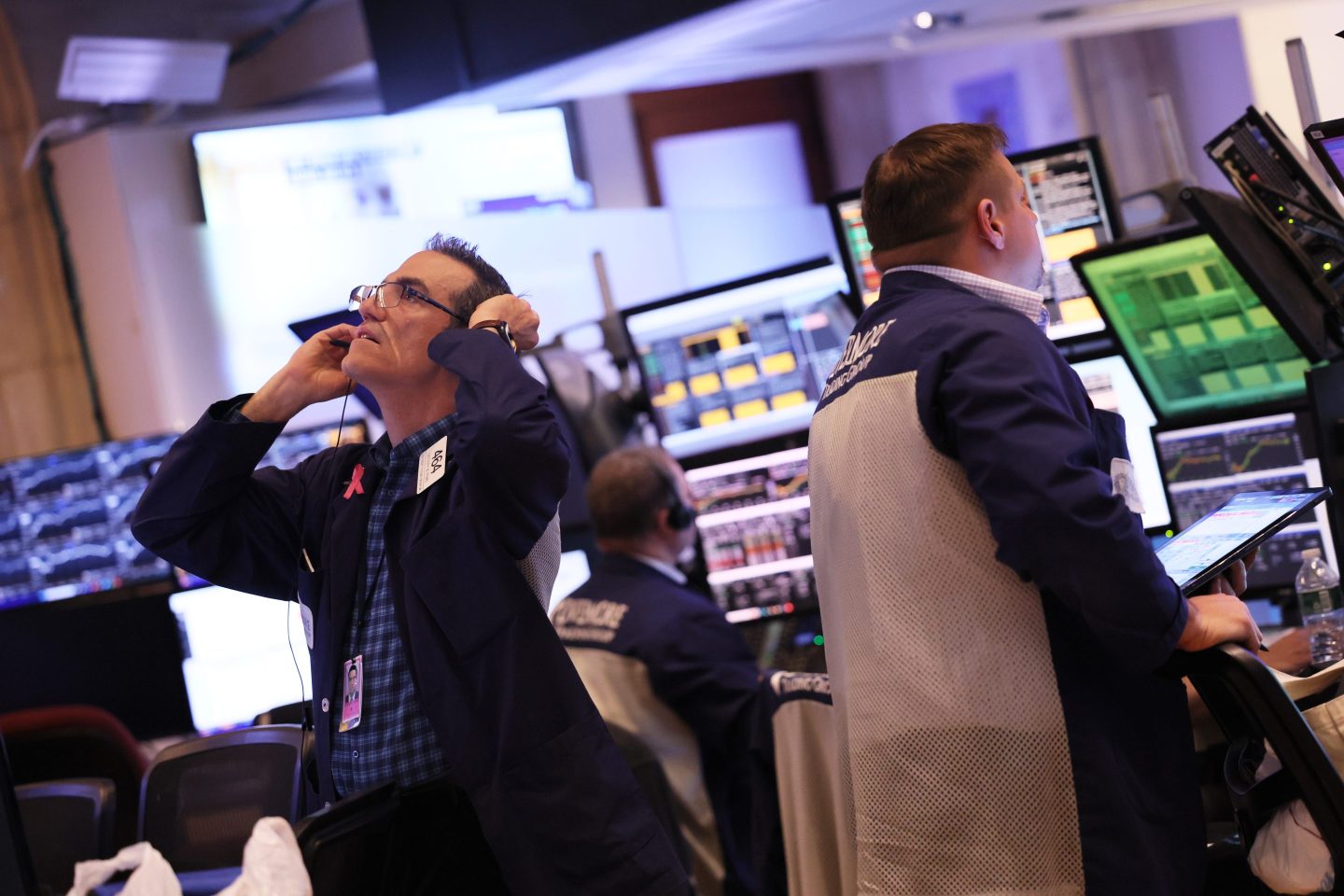
去年7月,迈克尔·加彭成为美国银行(Bank of America)首席经济学家。不久之后,他警告美国经济将在年底出现“轻度衰退”。加彭的前任们一直避免发布过度悲观的预测,但他担心,在持续通胀和加息的大环境下,美国经济可能出现最糟糕的状况。然而,去年9月,由于美国消费者支出和劳动力市场的表现超出他的预期,因此这位前巴克莱(Barclays)高管修改了自己的初始预测,他认为在今年上半年之前不会发生轻度衰退。
现在,与许多同行一样,事实证明加彭的预测至少有一点草率。尽管美国面临恶性通胀,亿万富翁投资者们也纷纷给出末日预测,但美国经济继续好转,失业率始终维持在接近疫情之前的最低水平,零售销售也极具韧性。股市经历过2022年的低迷之后也开始反弹。随着人工智能重塑全球经济的潜力引起投资者的投资热情,标普500指数从年初至今已经上涨了超过15%。
诸多好消息使加彭本周再次修改了对经济衰退的预测。现在他表示,美国经济会到2024年出现“更温和的”下滑。
他在周三的客户报告中写道:“考虑到好转的风险状况和其他证明经济韧性的证据,我们调整了预期经济下滑的时机。我们承认这并非我们第一次修改预测。”
加彭表示,他希望避免“预测未来六个月的长期经济下滑”,但他还表示,他依旧认为如果美联储想要控制通货膨胀,将不得不加息,直到失业率大幅升高为止。虽然上个月的通胀率从2022年6月最高的9.1%同比下降至4%,但依旧远高于美联储2%的目标通胀率。
加彭写道:“尽管如此,考虑到劳动力供应状况的好转,以及在没有失业率支持的情况下已经发生了通货紧缩的证据,我们降低了经济衰退的严重程度。我们现在预测,发生‘增长型衰退’和‘轻度衰退’的可能性相当。”
增长型衰退是指经济维持低速正向增长,但失业率上升,而单纯的经济衰退则是大范围的持续经济收缩,通常被定义为连续两个季度GDP负增长。
加彭表示,他之所以本周更新对经济衰退的预测,部分原因是移民增加和劳动力参与率提高所导致的“劳动力供应的快速反弹”。他表示,这种反弹帮助失业率维持在较低水平,并抑制了工资增长,使通货膨胀从2022年6月的四十年最高有所下降,但没有引发经济衰退。
加彭表示,最近几个月,美国经济增长面临的诸多风险开始消失。他提到了债务上限获得通过,以及三月硅谷银行(Silicon Valley Bank)倒闭后美联储采取的在区域银行“控制压力”的措施等。
他写道:“我们没有预测到债务上限危机的负面影响,但债务上限获得通过减少了不确定性。”此外,虽然现在宣布银行贷款的信用恐慌风险‘已全部解除’为时尚早,但区域银行业的压力并未变得更严重,而且到目前为止避免了危机蔓延。”
加彭还指出,拜登政府“旨在刺激制造业投资”的《芯片法案》(CHIPS)、《通胀削减法案》(Inflation Reduction Act)和《基础设施投资和就业法案》等,帮助促进了经济增长。
他表示,他现在预测今年第四季度,美国的GDP将增长1.1%,相比之下他在去年9月预测GDP将下降0.2%。但这位经济学家将对美国2024年GDP增长率的预测从0.9%下调至0%,因为他认为明年大部分时间,美国经济需要从上半年的增长型衰退后开始恢复。
美国银行并非唯一一家近期看好美国经济的投行。高盛(Goldman Sachs)经济学家本月早些时候也修改了其经济衰退预测,将美国今年发生经济衰退的概率从3月预测的35%下调至25%。Stifel也调整了预测,其分析师称在短期内美国不会发生“教科书式的经济衰退”。(财富中文网)
翻译:刘进龙
审校:汪皓
去年7月,迈克尔·加彭成为美国银行(Bank of America)首席经济学家。不久之后,他警告美国经济将在年底出现“轻度衰退”。加彭的前任们一直避免发布过度悲观的预测,但他担心,在持续通胀和加息的大环境下,美国经济可能出现最糟糕的状况。然而,去年9月,由于美国消费者支出和劳动力市场的表现超出他的预期,因此这位前巴克莱(Barclays)高管修改了自己的初始预测,他认为在今年上半年之前不会发生轻度衰退。
现在,与许多同行一样,事实证明加彭的预测至少有一点草率。尽管美国面临恶性通胀,亿万富翁投资者们也纷纷给出末日预测,但美国经济继续好转,失业率始终维持在接近疫情之前的最低水平,零售销售也极具韧性。股市经历过2022年的低迷之后也开始反弹。随着人工智能重塑全球经济的潜力引起投资者的投资热情,标普500指数从年初至今已经上涨了超过15%。
诸多好消息使加彭本周再次修改了对经济衰退的预测。现在他表示,美国经济会到2024年出现“更温和的”下滑。
他在周三的客户报告中写道:“考虑到好转的风险状况和其他证明经济韧性的证据,我们调整了预期经济下滑的时机。我们承认这并非我们第一次修改预测。”
加彭表示,他希望避免“预测未来六个月的长期经济下滑”,但他还表示,他依旧认为如果美联储想要控制通货膨胀,将不得不加息,直到失业率大幅升高为止。虽然上个月的通胀率从2022年6月最高的9.1%同比下降至4%,但依旧远高于美联储2%的目标通胀率。
加彭写道:“尽管如此,考虑到劳动力供应状况的好转,以及在没有失业率支持的情况下已经发生了通货紧缩的证据,我们降低了经济衰退的严重程度。我们现在预测,发生‘增长型衰退’和‘轻度衰退’的可能性相当。”
增长型衰退是指经济维持低速正向增长,但失业率上升,而单纯的经济衰退则是大范围的持续经济收缩,通常被定义为连续两个季度GDP负增长。
加彭表示,他之所以本周更新对经济衰退的预测,部分原因是移民增加和劳动力参与率提高所导致的“劳动力供应的快速反弹”。他表示,这种反弹帮助失业率维持在较低水平,并抑制了工资增长,使通货膨胀从2022年6月的四十年最高有所下降,但没有引发经济衰退。
加彭表示,最近几个月,美国经济增长面临的诸多风险开始消失。他提到了债务上限获得通过,以及三月硅谷银行(Silicon Valley Bank)倒闭后美联储采取的在区域银行“控制压力”的措施等。
他写道:“我们没有预测到债务上限危机的负面影响,但债务上限获得通过减少了不确定性。”此外,虽然现在宣布银行贷款的信用恐慌风险‘已全部解除’为时尚早,但区域银行业的压力并未变得更严重,而且到目前为止避免了危机蔓延。”
加彭还指出,拜登政府“旨在刺激制造业投资”的《芯片法案》(CHIPS)、《通胀削减法案》(Inflation Reduction Act)和《基础设施投资和就业法案》等,帮助促进了经济增长。
他表示,他现在预测今年第四季度,美国的GDP将增长1.1%,相比之下他在去年9月预测GDP将下降0.2%。但这位经济学家将对美国2024年GDP增长率的预测从0.9%下调至0%,因为他认为明年大部分时间,美国经济需要从上半年的增长型衰退后开始恢复。
美国银行并非唯一一家近期看好美国经济的投行。高盛(Goldman Sachs)经济学家本月早些时候也修改了其经济衰退预测,将美国今年发生经济衰退的概率从3月预测的35%下调至25%。Stifel也调整了预测,其分析师称在短期内美国不会发生“教科书式的经济衰退”。(财富中文网)
翻译:刘进龙
审校:汪皓
After taking over the chief economist gig at Bank of America last July, Michael Gapen quickly warned that the U.S. economy was headed for a “mild recession” by year’s end. Gapen’s predecessors had long avoided overly bearish predictions, but he feared the worst amid persistent inflation and rising interest rates. However, the former Barclays exec revised his initial forecast in September after consumer spending and the labor market “held up” better than he’d expected, arguing that a mild recession wouldn’t come until the first half of this year.
And now, as with many of his peers, Gapen’s forecasts have proven to be, at the least, a bit premature. Despite stubborn inflation and doomsday predictions from billionaire investors, the U.S. economy continues to push forward, with the unemployment rate sticking near pre-pandemic lows and retail sales proving to be resilient. The stock market has also rebounded after a dismal 2022. The S&P 500 is now up more than 15% year to date amid investors’ increasing enthusiasm over the potential for A.I. to reshape the global economy.
The good news forced Gapen to revise his recession forecast once again this week. He now says there’s going to be a “softer” downturn, and it won’t come until 2024.
“We have taken on board the improved risk backdrop and further evidence of resilience and moved out the timing of our anticipated downturn,” the economist wrote in a Wednesday note to clients. “We acknowledge that this is not the first time we have done so.”
Gapen said he wants to avoid “forecasting a perpetual downturn six months into the future,” but added that he still believes the Federal Reserve will be forced to raise interest rates until there is a significant increase in unemployment if it wants to tame inflation. Although year-over-year inflation slowed from its June 2022 high of 9.1% to 4% last month, it remains well above the central bank’s 2% target rate.
“That said, we have softened the magnitude of the downturn given the improved picture on labor supply and evidence that some disinflation has occurred without any real backup in the unemployment rate,” Gapen wrote. “Our forecast is now as much a ‘growth recession’ as it is a ‘mild recession.’”
A growth recession involves a period of low but positive economic growth and rising unemployment, whereas a pure recession is a period of widespread and sustained economic contraction, usually defined as two quarters of negative GDP growth.
Gapen said he updated his recession forecast this week due in part to a “rapid rebound in labor supply” caused by increased immigration and improved workforce participation rates. This rebound has helped the unemployment rate to remain low and held down wage growth, enabling inflation to fall from its June 2022 four decade high without sparking a recession, he said.
Risks to U.S. economic growth have also begun to fade in recent months, according to the economist, who pointed to examples like the passage of the debt ceiling and the Fed’s actions to “contain stresses” at regional banks after the blowup of Silicon Valley Bank in March.
“We did not expect adverse fireworks from a debt limit debacle, but nonetheless, its passing reduces uncertainty,” he wrote. “In addition, while it is too early to declare ‘all clear’ on risks of a credit crunch in bank lending, stresses in the regional banking sector do not appear to be getting worse, and spillovers have so far been avoided.”
Gapen also noted that the Biden Administration’s CHIPS and Inflation Reduction Act (IRA), and Infrastructure Investment and Jobs Act (IIJA), which are “aimed at spurring investment in the manufacturing sector,” have helped boost economic growth.
He said he now expects U.S. GDP to rise 1.1% in the fourth quarter of this year, compared to his September prediction for a 0.2% drop. But the economist lowered his forecast for 2024 GDP growth from 0.9% to 0%, arguing that the economy will spend much of next year recovering from its first-half growth recession.
Bank of America isn’t the only investment bank to turn bullish on the economy recently. Goldman Sachs economists revised their recession forecast earlier this month as well, arguing there is now just a 25% chance of a U.S. recession this year, down from 35% in March. And Stifel followed suit, with analysts claiming there won’t be a “textbook recession” anytime soon.






